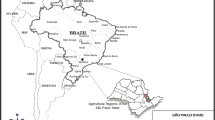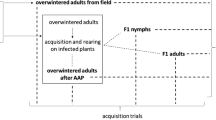Abstract
The percentage of passionfruit ringspot virus infection in batches of young passionfruit seedlings exposed in the open in a plot of diseased fully grown passionfruits was significantly correlated with the number of wingedAphis spiraecola trapped in yellow watertrays during the time of exposure.
Of all aphids trapped, 98% wereA. spiraecola, colonizing predominantlyEupatorium conyzoides (Compositae). This plant was found colonized everywhere in the forest area of Ivory Coast, which emphasizes the importance ofA. spiraecola as a potential virus vector in this part of Africa. The numbers of trappedA. spiraecola were positively correlated with the preceding rainfall in mm with an interval of two weeks before the assessment. The influence of a period of rainfall lasted four to six weeks.
Samenvatting
‘Passionfruit ringspot virus’ (PRV) werd in Ivoorkust in het veld zeer snel verspreid van oudere zieke naar gezonde jonge zaailingen vanPassiflora edulis, de passievrucht.P. edulis zelf bleek geen waardplant te zijn voor eventuele vectoren. De aantallen gevleugelde bladluizen, gevangen in gele vangbakken gedurende een bepaalde periode, bleken echter significant gecorreleerd te zijn met de percentages zieke planten van groepen jongePassiflora zaailingen die een overeenkomstige periode aan infectie in het veld hadden bloot gestaan.
Van het totaal aantal gevangen gevleugelde bladluizen bleekAphis spiraecola 98% uit te maken. Alleen deze bladluis werd verantwoordelijk gesteld voor de overdracht van het virus in het veld. Als waardplant voorA. spiraecola dient voornamelijk het meerjarig onkruidEupatorium conyzoides (Compositae), dat zeer algemeen voorkomt in de omgeving van de proefvelden van het ORSTOM. Ook elders in de regenbos-zone van Ivoorkust wordt deze plant algemeen aangetroffen met kolonies vanA. spiraecola, wat deze bladluis tot een belangrijke potentiële virusvector in dit deel van Afrika maakt.
De aantallen gevangen gevleugelde exemplaren vanA. spiraecola waren significant gecorreleerd met de twee weken daaran voorafgaande neerslaghoeveelheden. De invloed van een regenperiode hield 4–6 weken aan.
Similar content being viewed by others
References
A'Brook, J., 1968. The effect of planting date and spacing on the numbers of aphids trapped over the groundnut crop. Ann. appl. Biol. 61: 289–294.
Broadbent, L., 1967. The influence of climate and weather on the incidence of plant virus diseases Weather and Agriculture: 99–104. Pergamon Press, Oxford.
Broadbent, L., Chaudhuri, R. R. & Kapica, L., 1950. The spread of virus diseases to single potato plants by winged aphids. Ann. appl. Biol. 37: 355–362.
Eastop, V. F., 1961. A study of the Aphididae (Homoptera) of West Africa. British museum (Natural History), London.
Fritsche, R., Karl, E., Lehmann, W. & Proeseler, G., 1972. Tierische Vektoren pflanzenpathogener Viren. Fischer, Jena.
Gonzalez, D. & Rawlins, W. A., 1969. Relation to aphid population to field spread of lettuce mosaic virus in New York. J. econ. Ent. 52: 421–425.
Hall, J. B., Kumar, R. & Enti, A. A., 1972. The obnoxious weedEupatorium odoratum (Compositae) in Ghana. Ghana J. agric. Sci. 5: 75–78.
Hoof, H. A. van, 1962. Observations on aphid flights in Surinam. Entomologia exp. appl. 5: 239–243.
Lees, A. D., 1967. The produktion of apterous and alate forms in the aphidMegoura viciae Buckton, with special reference to the role of crowding. J. Insect Physiol. 13: 289–318.
Lewis, T., 1965. The effect of an artificial windbreak on the aerial distribution of flying insects. Ann. appl. Biol. 55: 503–512.
Matisova, J., 1971. Efficiency of alfalfa mosaic virus transmission by aphids in relation to the level of virus in plants. Acta Virol., Prague, 15: 411–420.
Mueller, H. J., 1964. Ueber die Anflugdichte von Aphiden auf farbigen Salatpflanzen. Entomologia exp. appl. 7: 85–104,
Nelson, M. R. & Tuttle, D. M., 1969. The epidemiology of cucumber mosaic virus and watermelon mosaic virus 2 of cantaloupe in an arid climate. Phytopathology 59: 849–856.
O'Loughlin, G. T., 1963. Aphid trapping in Victoria. I. The seasonal occurrence of aphids in three localities and a comparison of two trapping methods. Aust. J. agric. Res. 14: 61–69.
Simons, J. N., 1958. Titers of three non-persistent aphid-borne viruses affecting peppers in South Florida. Phytopathology 48: 265–268.
Swenson, K. G., 1962. Bean yellow mosaic virus transmission byMyzus persicae. Aust. J. biol. Sci. 15: 468–482.
Watson, M. A. & Healy, M. J. R., 1953. The spread of beet yellows and beet mosaic viruses in the sugarbeet root crop. Ann. appl. Biol. 40: 189–193.
Wijs, J. J. de, 1973. Pepper veinal mottle virus in Ivory Coast. Neth. J. Pl. Path. 79: 189–193.
Wijs, J. J. de, 1974. A virus causing ringspot ofPassiflora edulis in the Ivory Coast. Ann. appl. Biol. 77: 33–40.
Author information
Authors and Affiliations
Rights and permissions
About this article
Cite this article
De Wijs, J.J., Bos, L. The correlation between the transmission of passionfruit ringspot virus and populations of flying aphids. Netherlands Journal of Plant Pathology 80, 133–144 (1974). https://doi.org/10.1007/BF01981377
Accepted:
Issue Date:
DOI: https://doi.org/10.1007/BF01981377




